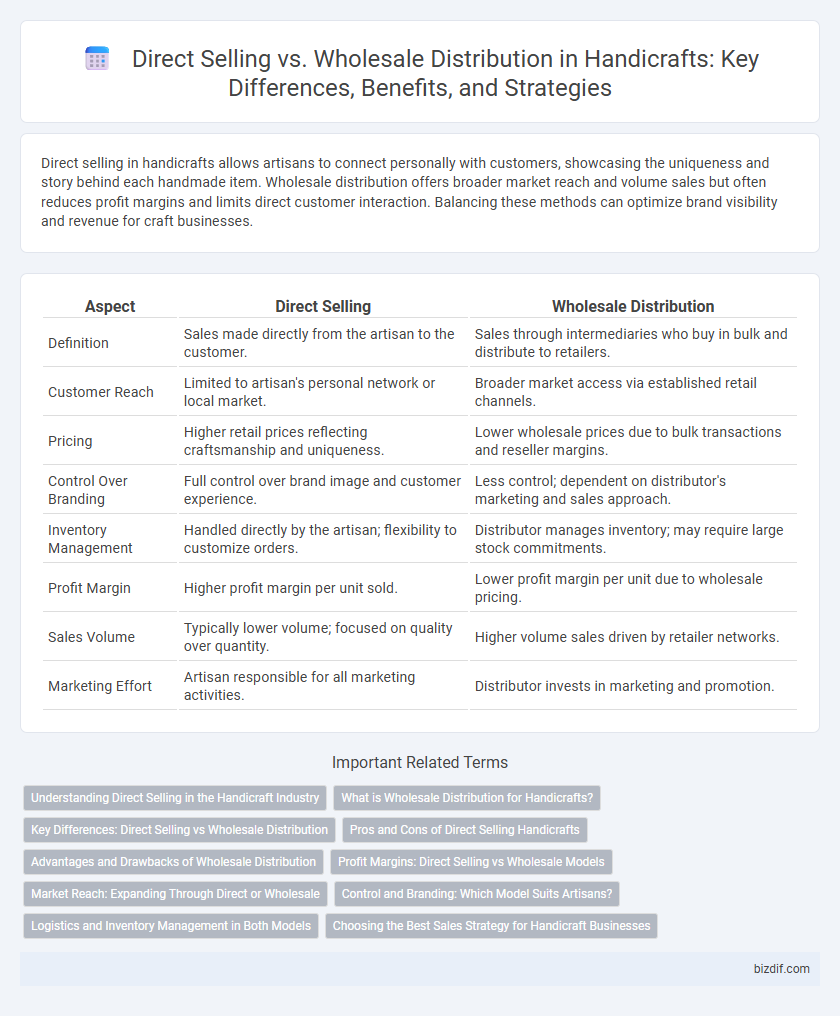Direct selling in handicrafts allows artisans to connect personally with customers, showcasing the uniqueness and story behind each handmade item. Wholesale distribution offers broader market reach and volume sales but often reduces profit margins and limits direct customer interaction. Balancing these methods can optimize brand visibility and revenue for craft businesses.
Table of Comparison
| Aspect | Direct Selling | Wholesale Distribution |
|---|---|---|
| Definition | Sales made directly from the artisan to the customer. | Sales through intermediaries who buy in bulk and distribute to retailers. |
| Customer Reach | Limited to artisan's personal network or local market. | Broader market access via established retail channels. |
| Pricing | Higher retail prices reflecting craftsmanship and uniqueness. | Lower wholesale prices due to bulk transactions and reseller margins. |
| Control Over Branding | Full control over brand image and customer experience. | Less control; dependent on distributor's marketing and sales approach. |
| Inventory Management | Handled directly by the artisan; flexibility to customize orders. | Distributor manages inventory; may require large stock commitments. |
| Profit Margin | Higher profit margin per unit sold. | Lower profit margin per unit due to wholesale pricing. |
| Sales Volume | Typically lower volume; focused on quality over quantity. | Higher volume sales driven by retailer networks. |
| Marketing Effort | Artisan responsible for all marketing activities. | Distributor invests in marketing and promotion. |
Understanding Direct Selling in the Handicraft Industry
Direct selling in the handicraft industry involves artisans or small producers selling their handmade products directly to consumers without intermediaries, enabling higher profit margins and personalized customer relationships. This model emphasizes craftsmanship authenticity and unique product stories, which resonate more effectively in direct interactions compared to wholesale distribution. Direct selling also allows for flexible pricing strategies and faster feedback loops, crucial for adapting to consumer preferences within the niche handicraft market.
What is Wholesale Distribution for Handicrafts?
Wholesale distribution for handicrafts involves purchasing handmade products in bulk directly from artisans or manufacturers and selling them to retailers or businesses at a lower per-unit cost. This method enables artisans to reach larger markets without managing individual sales, providing consistent demand and streamlined inventory management. Wholesale distributors play a crucial role in expanding the reach of handcrafted goods while maintaining competitive pricing and supply chain efficiency.
Key Differences: Direct Selling vs Wholesale Distribution
Direct selling in handicraft involves artisans or small businesses selling products directly to consumers, enhancing profit margins and personalized customer interaction. Wholesale distribution focuses on large-scale product supply to retailers or other businesses, emphasizing volume discounts and broader market reach. Key differences include control over pricing, customer relationship management, and inventory handling, with direct selling enabling stronger brand storytelling and wholesale distribution driving bulk order efficiency.
Pros and Cons of Direct Selling Handicrafts
Direct selling handicrafts allows artisans to maintain full control over pricing, customer interaction, and brand storytelling, fostering stronger customer loyalty and higher profit margins. This approach can be time-intensive and requires robust marketing skills, limiting scalability compared to wholesale distribution. However, it offers immediate feedback from consumers, enabling artisans to quickly adapt products to market demands and personalize the shopping experience.
Advantages and Drawbacks of Wholesale Distribution
Wholesale distribution in handicrafts offers the advantage of reaching a broader market quickly through established retailer networks, enabling higher sales volumes and consistent cash flow. However, it often involves lower profit margins due to bulk pricing and reduced control over product presentation, which can impact brand perception. Managing inventory and logistics can also be complex, requiring significant coordination between artisans and distributors to maintain quality and timely delivery.
Profit Margins: Direct Selling vs Wholesale Models
Direct selling in handicraft allows artisans to capture higher profit margins by eliminating intermediaries and selling products directly to consumers. Wholesale distribution often results in lower profit margins due to bulk pricing and distributor fees, but it enables faster inventory turnover and broader market reach. Optimizing profit margins depends on balancing the higher per-unit earnings of direct sales with the volume advantages of wholesale channels.
Market Reach: Expanding Through Direct or Wholesale
Direct selling in handicrafts enables artisans to establish personal connections with customers, fostering loyalty and allowing for tailored product presentations that can enhance market reach within niche segments. Wholesale distribution leverages established retailer networks to rapidly scale product availability, increasing exposure across broader geographic areas and diverse customer bases. Balancing direct customer engagement with wholesale partnerships optimizes market penetration and drives sustainable growth for handicraft businesses.
Control and Branding: Which Model Suits Artisans?
Direct selling enables artisans to maintain full control over product presentation and brand identity, fostering a personal connection with customers. Wholesale distribution often requires relinquishing branding control, as intermediaries influence how products are marketed and displayed. For artisans seeking to preserve authenticity and brand consistency, direct selling offers a strategic advantage in niche handicraft markets.
Logistics and Inventory Management in Both Models
Direct selling in handicraft businesses demands streamlined logistics and real-time inventory management to handle individual orders efficiently, ensuring quick delivery and personalized customer service. Wholesale distribution relies on bulk inventory storage and coordinated logistics networks to manage larger stock volumes, emphasizing cost-effective transportation and warehouse management. Effective inventory tracking systems are critical in both models to minimize stockouts, reduce holding costs, and maintain product quality.
Choosing the Best Sales Strategy for Handicraft Businesses
Direct selling offers handcrafted artisans personalized customer interactions and higher profit margins by eliminating intermediaries, enhancing brand storytelling and customer loyalty. Wholesale distribution enables broader market reach and faster inventory turnover but often reduces per-unit profit due to retailer markup and bulk pricing. Handicraft businesses must evaluate market demand, production capacity, and brand positioning to select the optimal sales strategy for sustainable growth.
Direct Selling vs Wholesale Distribution Infographic

 bizdif.com
bizdif.com